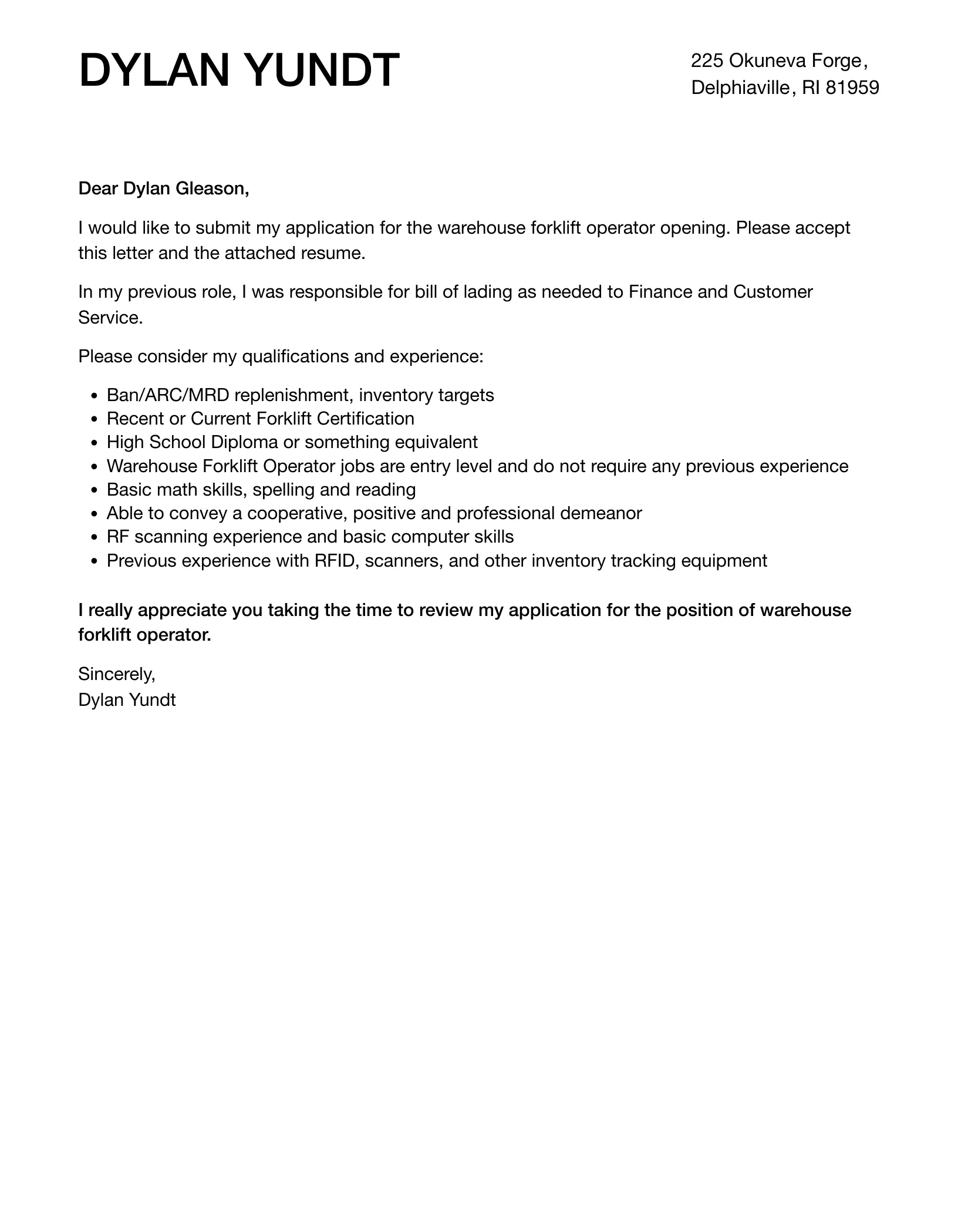Understanding the Forklift Operator Cover Letter
A forklift operator cover letter is a crucial document that accompanies your resume when applying for forklift operator positions. It serves as your introduction to a potential employer, allowing you to showcase your skills, experience, and enthusiasm for the role. Unlike a resume, which provides a factual overview of your qualifications, a cover letter enables you to highlight specific achievements and tailor your application to the job requirements. Writing a compelling cover letter is an essential step in the job application process, helping you stand out from other candidates and increase your chances of landing an interview.
Purpose of a Forklift Operator Cover Letter
The primary purpose of a forklift operator cover letter is to persuade the hiring manager to consider your application. It provides an opportunity to express your interest in the position, explain why you are a good fit for the company, and demonstrate how your skills and experience align with the job’s needs. A well-written cover letter should complement your resume by providing context to your qualifications and highlighting aspects of your background that are most relevant to the role. The cover letter also allows you to personalize your application and communicate your personality and passion for the forklift operator profession, setting the stage for a potential interview.
Key Components of a Forklift Operator Cover Letter
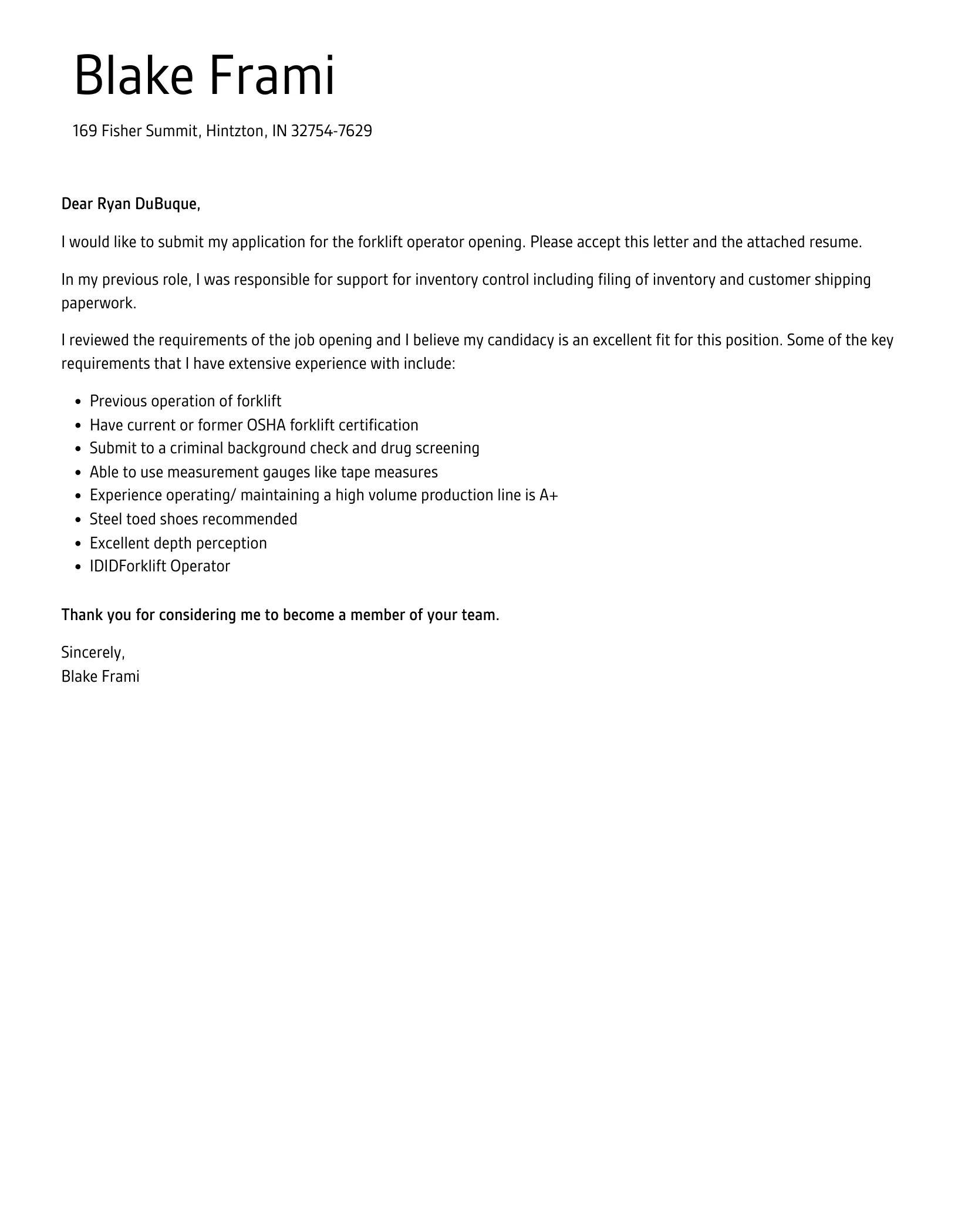
A strong forklift operator cover letter includes several essential components that work together to present a compelling case for your candidacy. These components, each playing a vital role, include your contact information, the date, recipient details, a professional salutation, a captivating opening paragraph, clear showcasing of your skills and experience, a tailored closing, and a formal closing. Each section contributes to painting a complete picture of your qualifications and enthusiasm. A well-structured cover letter is easier to read and more effective at capturing the hiring manager’s attention.
Contact Information
At the top of your cover letter, include your full name, address, phone number, and email address. This information ensures the hiring manager can easily contact you. Make sure your email address is professional and appropriate for a job application. Verify the contact information is correct and up-to-date.
Date and Recipient Information
Below your contact information, include the date you are writing the letter. Following the date, provide the hiring manager’s name (if known), their title, the company name, and the company’s address. If you are unsure of the hiring manager’s name, research the company website or LinkedIn to find the appropriate contact person. Addressing your letter to a specific person shows that you have taken the time to learn about the company and the job opening.
The Salutation
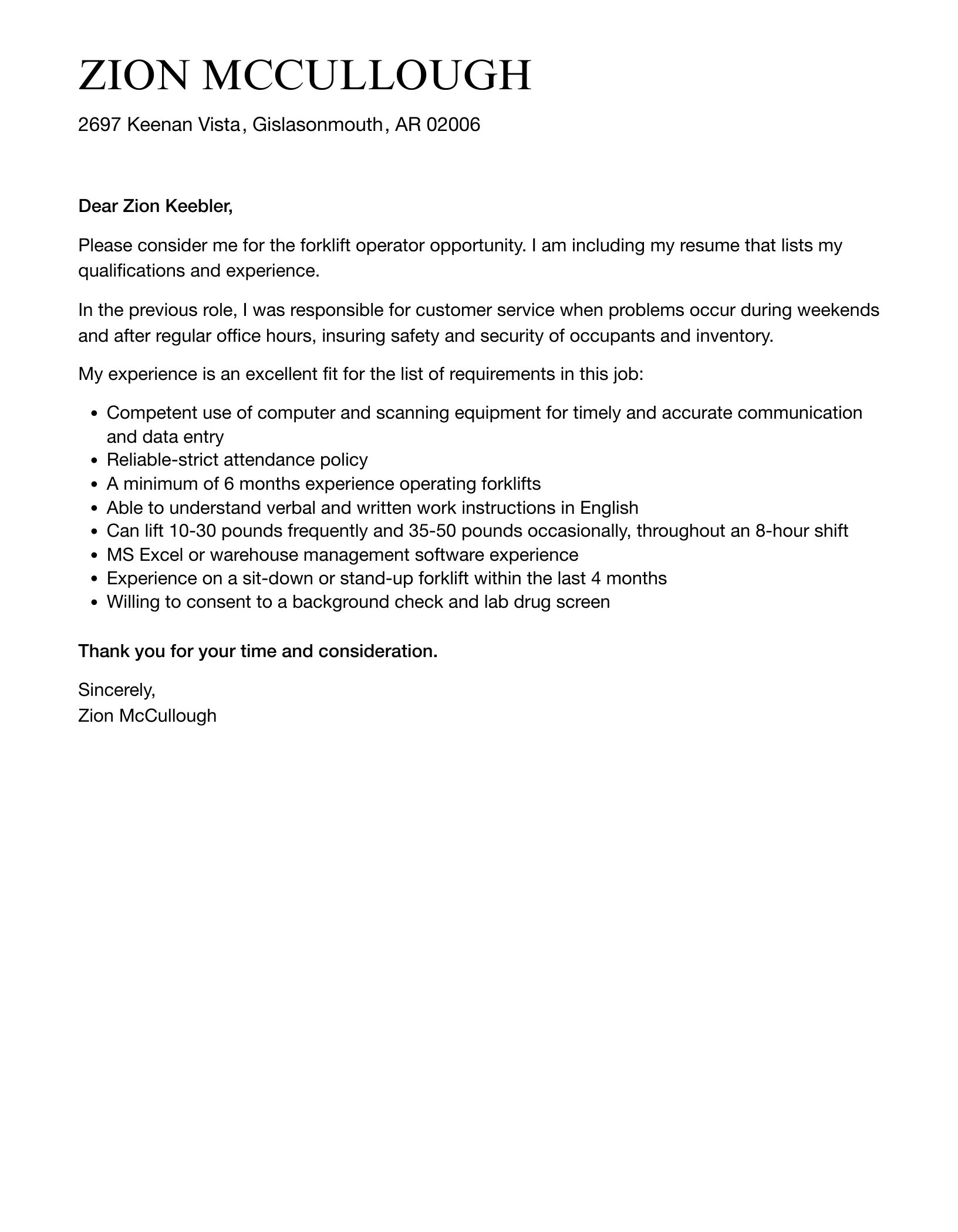
Begin your cover letter with a professional salutation. If you know the hiring manager’s name, use “Dear Mr./Ms. [Last Name].” If you are unsure of the hiring manager’s name, use a general salutation, such as “Dear Hiring Manager” or “Dear [Company Name] Hiring Team.” Avoid using generic salutations like “To Whom It May Concern,” as they make your letter appear impersonal. Ensuring the salutation is correct sets the tone for the rest of your cover letter.
Crafting the Perfect Opening Paragraph
The opening paragraph should grab the reader’s attention and clearly state the purpose of your letter. Begin by expressing your interest in the forklift operator position and mentioning where you saw the job posting. Briefly highlight your relevant skills and experience, and then express your enthusiasm for the opportunity. For example, “I am writing to express my keen interest in the Forklift Operator position at [Company Name], as advertised on [Platform]. With [Number] years of experience operating forklifts and a strong track record of safety and efficiency, I am confident I can contribute significantly to your team.”
Highlighting Your Forklift Skills and Experience
The main body of your cover letter should detail your forklift skills and experience. This is where you showcase your qualifications and explain why you are the best fit for the role. Use specific examples to demonstrate your abilities. Mention your experience with different types of forklifts, such as electric, gas, or propane-powered models. Highlight any specialized skills, such as operating in tight spaces, loading and unloading trailers, or handling various types of materials. Emphasize your knowledge of safety procedures and your commitment to following them.
Certifications and Licenses
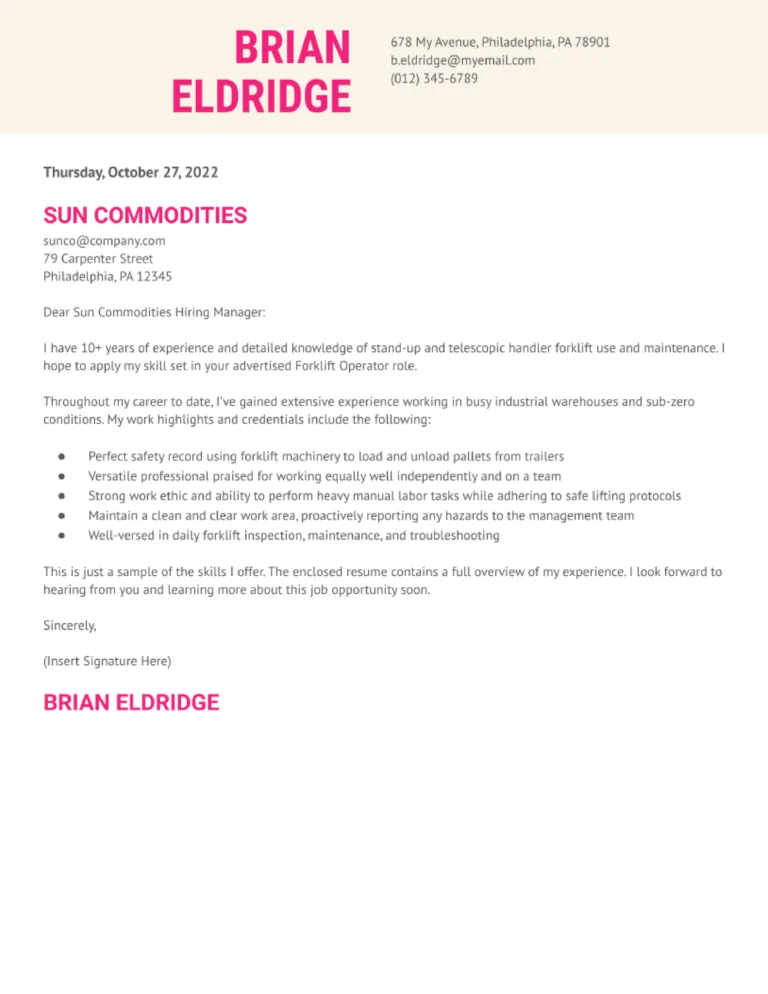
Clearly state your forklift certifications and licenses. Include the specific certifications you hold, such as a valid forklift operator license and any other relevant safety certifications. Mention the issuing authority and the expiration dates of your certifications. If you have recently renewed any certifications, be sure to include that information. Make sure your certifications are up-to-date and valid, as this is a critical requirement for most forklift operator positions.
Quantifiable Achievements
Whenever possible, quantify your achievements to demonstrate your impact. Use numbers to illustrate your successes, such as the amount of materials handled, the reduction in accidents, or the improvement in efficiency. For example, “Successfully handled an average of 50 pallets per hour, increasing warehouse efficiency by 15%.” Quantifiable achievements provide concrete evidence of your capabilities and make your application more compelling. Use the STAR method (Situation, Task, Action, Result) to give context to the achievements.
Showcasing Relevant Skills
List and describe skills relevant to the job. These could include experience with warehouse management systems, inventory control, or preventative maintenance. Detail your experience with the specific types of forklifts mentioned in the job description. Show how your skills meet the requirements outlined in the job posting. Highlighting relevant skills makes your cover letter more targeted and demonstrates that you have the abilities needed to succeed in the position.
Addressing the Employer’s Needs
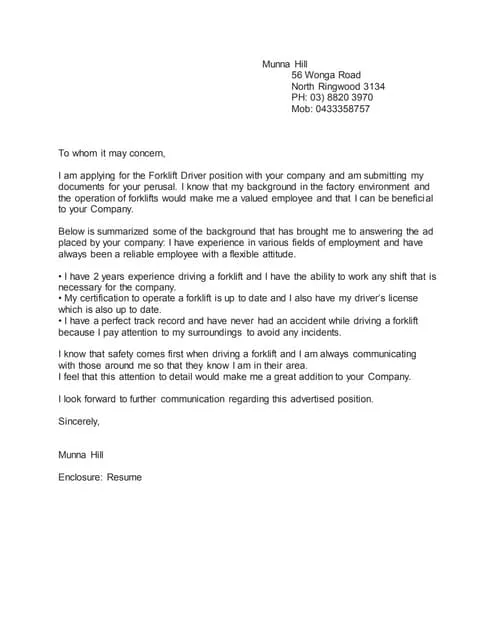
In your cover letter, it’s important to address the employer’s needs and show how your skills and experience can help them achieve their goals. Carefully review the job description and identify the key requirements and responsibilities. Then, explain how your qualifications align with these needs and provide examples of how you have successfully met similar challenges in the past. Tailoring your letter to the employer’s needs demonstrates that you understand the role and are committed to contributing to the company’s success.
Researching the Company
Before writing your cover letter, take the time to research the company. Learn about their products or services, their mission and values, and any recent news or developments. Showing that you understand the company’s business and culture will make your cover letter more relevant and show the hiring manager that you are genuinely interested in the position. Mention something specific about the company that appeals to you, such as their reputation for safety or their commitment to employee development.
Tailoring Your Letter
Customize your cover letter for each job application. Avoid using a generic template and tailor your letter to the specific requirements of the position and the company. Highlight the skills and experiences that are most relevant to the job. Research the company and mention something specific about them. Demonstrating the ability to tailor your letter will demonstrate your attention to detail and your interest in the specific opportunity.
Closing Your Cover Letter Effectively
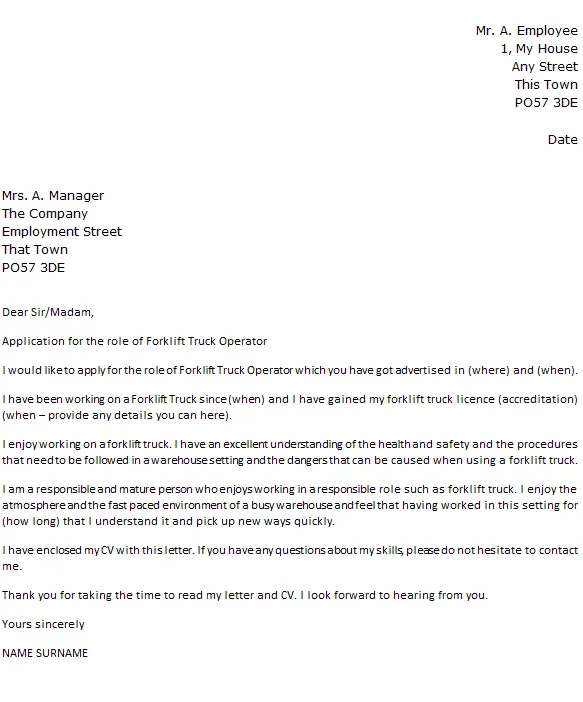
The closing of your cover letter is your final opportunity to make a positive impression. It should express your enthusiasm for the opportunity, reiterate your interest, and make it easy for the employer to contact you. A strong closing paragraph can leave a lasting impact and increase your chances of getting an interview. Ensure you end with a professional, polite tone that reinforces your interest in the role.
Expressing Enthusiasm and Availability
Reiterate your enthusiasm for the position and the company in your closing paragraph. State that you are eager to learn more about the opportunity and discuss your qualifications further. Mention that you are available for an interview at their earliest convenience. This shows your proactive nature and your genuine interest in the job.
The Formal Closing
Conclude your cover letter with a formal closing. Use a professional closing such as “Sincerely,” “Best regards,” or “Yours sincerely.” Follow this with a blank line for your signature (if printing and mailing the letter) and then your typed full name. Ensure your closing is consistent with the tone of your letter. Proofread your closing, along with your entire letter, to catch any errors.
Proofreading and Formatting Your Cover Letter
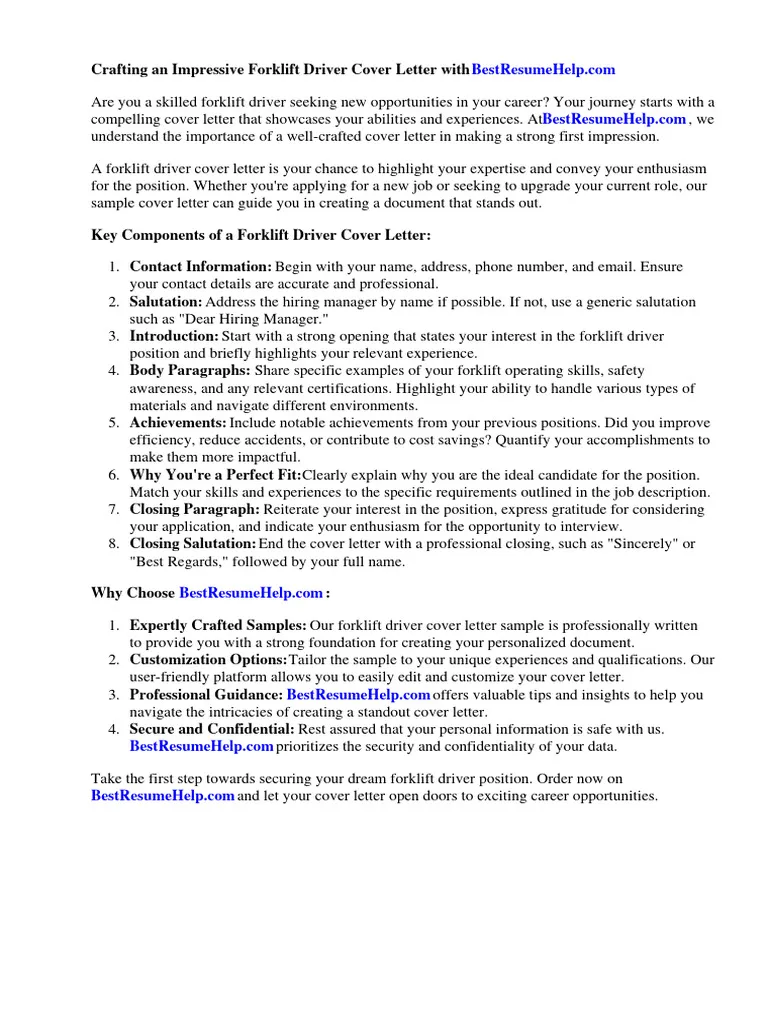
Before submitting your cover letter, carefully proofread it for any errors in grammar, spelling, and punctuation. A polished cover letter shows attention to detail and professionalism. Incorrect grammar and spelling mistakes detract from your credibility. Use a spell checker and grammar checker, but also read the letter carefully yourself to catch any errors that might be missed by automated tools.
Avoiding Common Mistakes
Avoid common mistakes that can undermine your cover letter. These include typos, grammatical errors, generic cover letters, and poor formatting. Ensure your cover letter is tailored to the job and company. Make sure your formatting is clear and easy to read. Mistakes can reflect negatively on your attention to detail and professionalism. Always proofread your cover letter carefully before submitting it to avoid these pitfalls.
Typos and Grammatical Errors
Typos and grammatical errors can make your cover letter appear unprofessional. Always proofread your letter carefully to catch any mistakes. Consider having a friend or family member review it as well. Errors can damage your credibility and make the hiring manager question your attention to detail. Proofreading is essential to ensure your letter reflects your best qualities and skills.
Generic Cover Letters
Avoid using generic cover letters that are not tailored to the specific job and company. Generic letters often lack the personalization and detail that make your application stand out. Tailor your cover letter to each job application, demonstrating that you understand the requirements of the role and are genuinely interested in the company. A tailored cover letter shows that you have taken the time to research the company and the position, which increases your chances of getting an interview.
Length and Formatting
Keep your cover letter concise and well-formatted. Aim for a length of one page, using a clear, easy-to-read font such as Times New Roman or Arial. Use standard margins (1 inch on all sides) and double-space between paragraphs. The formatting should be professional and easy to navigate. A well-formatted letter is easier to read and makes a better impression on the hiring manager. Make sure the layout looks clean and professional.
Using Strong Action Verbs
Use strong action verbs to describe your skills and experience. Action verbs make your cover letter more dynamic and engaging. They help the reader quickly understand your accomplishments and contributions. Begin each bullet point or description with a strong verb like “Operated,” “Managed,” “Implemented,” or “Improved.” This will make your letter more impactful and demonstrate your active role in your past experiences.
Examples of Action Verbs
Examples of action verbs include “operated,” “loaded,” “unloaded,” “inspected,” “maintained,” “organized,” “coordinated,” “managed,” “supervised,” “implemented,” and “improved.” Use a variety of action verbs to describe your accomplishments and responsibilities. Avoid repeating the same verbs throughout your letter. The right action verbs can help illustrate your skills and impact.
Cover Letter Examples for Forklift Operators
Refer to cover letter examples to guide your writing. Many online resources provide cover letter templates and examples for forklift operators. Use these examples as a starting point, but always personalize your letter to fit your skills and the specific job requirements. Adapt the examples to your experience and tailor them to match the job description. Reviewing examples can provide you with ideas on formatting, language, and how to highlight relevant skills and achievements.
Entry-Level Forklift Operator Cover Letter
For entry-level positions, focus on any relevant experience, training, and education. Highlight any forklift certifications or licenses you possess. If you have no prior forklift experience, emphasize transferable skills, such as attention to detail, safety consciousness, and a strong work ethic. Showcase any related experience such as warehouse work, logistics, or material handling. Express your enthusiasm for the opportunity to learn and grow within the company.
Experienced Forklift Operator Cover Letter
For experienced forklift operators, emphasize your years of experience and any specific skills or accomplishments. Highlight your expertise with different types of forklifts and materials. Quantify your achievements whenever possible, such as the number of pallets moved or the reduction in accidents. Mention any safety awards or recognition you have received. Demonstrate your understanding of warehouse operations and your commitment to safety and efficiency. Tailor the experience to meet the employer needs.
Reviewing and Submitting Your Cover Letter
Before submitting your cover letter, review it carefully to ensure it is free of errors and tailored to the specific job. Make sure your contact information is correct. Verify that you have addressed all the requirements of the job description. Review the letter for clarity, conciseness, and professionalism. A well-reviewed cover letter will make a positive impression.
Formatting and Saving Your Document
Save your cover letter as a PDF file to maintain its formatting. PDF files ensure that your cover letter will appear as you intended, regardless of the software or device used by the recipient. Name your file with your name and the job title (e.g., “JohnDoe_ForkliftOperator_CoverLetter.pdf”). This will help the hiring manager organize your application with ease. Verify the formatting of your document.
Submitting Your Cover Letter with Your Resume
Always submit your cover letter and resume together when applying for a forklift operator position. Follow the instructions provided in the job posting for submitting your application. Usually, you will be asked to attach both documents when applying online. When submitting both, make sure your name and the job title is easily identifiable. Double-check that you have included both documents. Your cover letter is meant to introduce and emphasize your skills and experiences.
